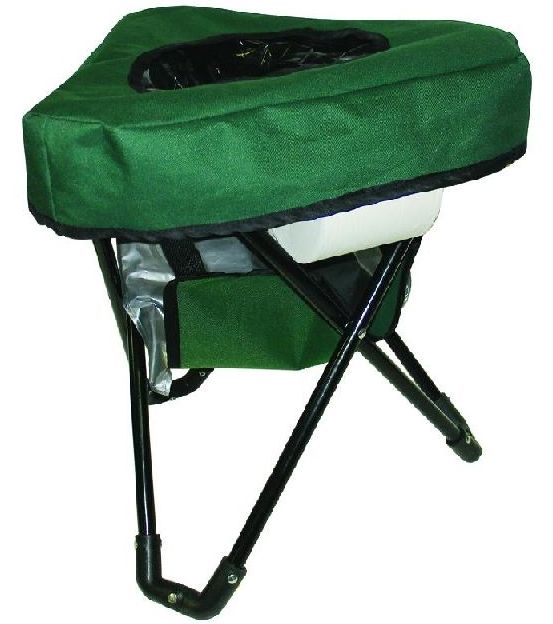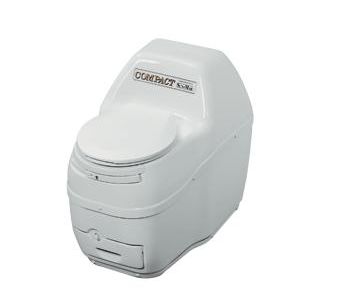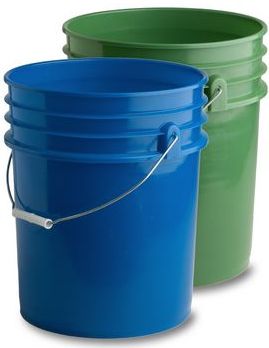Last month, our water was off for 12 hours. Luckily, we have plenty of water stockpiled. Since it wasn’t a major disaster, we were able to use our water reserves for flushing the toilet. But, in a real emergency, you aren’t going to want to waste an entire gallon of your precious water just for flushing.
And, in survival situations where you’ve got to hunker down in your safe room (such as after a nuclear attack), going into the bathroom might not even be an option. This is why you’ve got to make a plan for your emergency toilet. Otherwise, there will be a whole ‘nother definition to SHTF!
Emergency Toilet Options:
- Camping Toilets
- Compost Toilets
- Twin Bucket Toilets
Camping Toilets
Pros: These are inexpensive, simple solutions for short-term disasters.
Cons: They fill up quickly and are unsuitable for long-term disasters. You will need to have somewhere to put all of that waste. Even if it is bagged, it can still be smelly and messy!

Compost Toilets
Pros: This is a great off-grid toilet and sanitation option. It is very sanitary, has no smell, and would be good for a long-term solution.
Cons: Compost toilets are expensive to buy. You can build one yourself, but it would require extensive construction and supplies. They also need venting or should be in an outdoor location – which wouldn’t be suitable if you need to hide out in your home.
Recommended Reading: Best Indoor Composting Toilet

Twin Bucket Toilets
Pros: This system is very easy to make, is suitable for long-term disasters, and can be placed virtually anywhere.
Cons: You eventually will have to dispose of waste, and you will need to stockpile some sort of carbon material for the fecal matter.

Why the Twin Bucket System is the Best
If you have a Bug Out location, such as a cabin in the wilderness, then I’d definitely go with a compost toilet. But, for most emergency situations, the Twin Bucket Toilet system is the best. This is the system that the official websites of many states and localities recommend.
The Logic of Separating Pee and Poo
When talking about human waste, it is poo that contains harmful pathogens. Pee is generally very sterile. You can simply dump pee out in your yard to dispose of it. The pee will even act as a fertilizer! You cannot do this with poo because it could quickly cause the spread of disease.
Also consider that a day’s worth of pee has 10x the volume of poo. When you keep the two separate, it becomes much easier to dispose of each.
How to Build a Two Bucket Toilet System
You Will Need:
- Two 5-gallon buckets with tight-fitting lids
- Lots of plastic/vinyl bags (ideally thick bags; you don’t want to use plastic grocery bags for containing your poo!)
- Twist ties
- Carbon material (such as shredded paper, sawdust, or even kitty litter)
- Toilet paper
- Antibacterial hand sanitizer
- Toilet seats (optional)
- Plastic gloves
Instructions:
- Label one bucket “pee” and the other “poo”
- Put the buckets in a private place where toilet paper and the carbon material are located.
- Line the poo bucket with a plastic bag. The pee bucket does not need to be lined.
- Put toilet seats on top of the buckets if you wish.
Using the Pee Bucket
- Remove the lid and attach toilet seat, if necessary
- Do your business. DO NOT PUT TOILET PAPER IN THE PEE BUCKET! It should go in the poo bucket or a trash can.
- Remove the toilet seat and recover the bucket with the lid.
- When the pee bucket is full, dump the urine over the ground or down the drain (if sewage system is still working)
Using the Poo Bucket
- Remove the lid and attach the toilet seat, if necessary
- Do your business. Try not to pee into the poo bucket.
- Sprinkle about ½ to 1 cup of the carbon material over the poo.
- Depending on how long the disaster is likely to last and how many plastic bags you have, you can use twist ties to close the plastic bag after each use and reline the bucket, or you can simply re-cover the poo bucket and tie off the bag when it gets full.
- Put the poo bags in a secure place (such as a large trash can as far away from your living area as possible) until you can dispose of the waste.
Disposing of Poo
You cannot put human waste in with the regular trash! After the disaster is over, call your city’s health and sanitation department for instructions on where to bring your waste for proper disposal.
Alternatively, you can bury your waste. You will need to dig a hole at least 3 feet deep. The hole should be downhill from any water supply, like wells. It should also be ideally 50 feet away from living spaces.
The problem with this method is that your poo will be in plastic bags, so it will not be exposed to elements and decompose. But the idea of dumping the poo out of those plastic bags is really gross…
One alternative option is to line your poo bucket with newspaper and wrap the poo up with newspaper instead of plastic. But this isn’t as sanitary, especially since some pee will inevitably get into the poo bucket.
Notes:
Female hygiene products should also go into the poo bucket. Since these items are going to run out quickly in an emergency situation, I’d recommend switching to a menstrual cup. My wife uses one and loves it.
Diapers should go in their own bucket. Otherwise, the poo bucket will fill up too quickly. I hope you have enough diapers stockpiled!
You could use reusable cloth diapers (which will also save you tons of money) with plastic covers. The problem with this is that you’d have to wash them, and you might not have enough water depending on the survival situation. So be prepared with a stockpile of diapers at home and some cloth diapers in your family Bug Out Bag.
Can you imagine yourself using a bucket toilet? Let us know in the comments.



To prepare for a long term situation (weeks+) dig a 5 foot (or more) deep pit for waste disposal (as mentioned, away from your living area and any surface or well water). Use biodegradable bags in your poo bucket and take the twist tie off before throwing in the pit. If you are not on the move, keep a couple 50 lb bags of lime, protected from weather, and spread lime over the waste, a little sawdust too if available . Keep the pit covered… don’t want anything/anybody falling in. 🙂
Hi Guys, I use 2 five gallon buckets at my tree stand, one filled with cedar chips as I cut a lot of cedar in my wood shop, the other bucket has T-seat and a layer of cedar chips. When I have to I pull Poo bucket up through the floor do my poop lower it back down, then when I get down I put more chips in the poo bucket and at the end of the deer season I just dump the bucket in a hedge row and it’s gone in no time!
That sounds like a perfect setup!
If you live in an off grid house; there is a solution to this problem. You can buy a toilet with a built in electric incinerator.The incinerator is powered by a 12 volt car battery. I’ve seen ads for it in MOTHER EARTH MAGAZINE’s classified section.
That’s a great solution. Thank you for bringing it up. Though this post was more for emergency situations as most people (unfortunately) don’t live in off-grid houses.
Rod suggested using an ice cream bucket, great idea. But if you’re trying to creat a set up for children what about putting a two liter bottle filled with sand in the tank? It displaces water and gives the flush they are used to. You can fill the tank with grey water before bedtime and if there a nighttime need -taDa.
My grandparents lived through the depression and had lots of “tales” they thrilled us with as kids.
How much weight will the bucket hold?
Most GOOD buckets will hold 12-15 pounds since poo is really not all that heavy by itself. How do I know? We weighed it at deer camp. However, remember not all buckets are created equal. I have seen them as large as 8-gallon and as small as1/2 gallon, and some very thin and others very thick. Try to stay with a good 5-gallon especially made for this. Even Lowe’s has some good buckets that may do well.
they do make seats for the buckets. We use them at SCA events or use a portable commode. And e always have plenty of sawdust!
I have the 2-pail emergency toilet on hand for SHTF but at 71 all of my experience has been with outhouses, conventional & low flush toilets, & hydropower failures resulting in no water pressure for flushing. So I truly have never had to deal with the crapper not working for an extended period of time, say, more than 18 hours. Sitting on a 5 gallon pail feels a bit unsettling but it’s better than nothing.
If you don’t have a seat you can use a pool noodle!! Split the sides and wrap the rim. Even helps hold the bag in place!!
Assuming the drain system is working, low-flush toilets do not require much water to flush solids. I experimented on several occasions, found that a 2-litre plastic ice cream container carries the perfect amount. Dump it quickly into the bowl, & everything disappears. Pour slowly & it won’t work to flush things away. If you pour it into the tank, you will need much more water to get a flush.
Even an old conventional toilet on a septic system will flush this way if you don’t use the tank but suddenly dump a few litres of water in the bowl. Experiment before you are faced with a disaster. Be prepared.
Good info Rod. Thanks for that.
Glad to hear you are OK, good luck with the clean up.
Heading home to a location without running water after a major hurricane hit. Not sure what we are going into. I have lived without running water before, but still prefer my flushable toilet. I will be using tbe 2 can method if its needed when we get there.
We use them on our unimproved property, we use a trash bag for the purpose that is biodegradable. We dispose of them in a 5 or 6 foot deep pit with chips, wood chips from a saw mill.